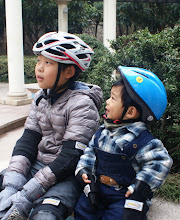An Indoor Well
We have been in Suzhou for almost 2 years and are eligible for applying for the Suzhou Garden's Cards. With the Garden's Card, we paid a fixed annual fee and can enjoy 100 visits to those "Expensive" Chinese gardens in Suzhou. We like to go outdoors on Sundays and are sort of out of old towns to visit. Our next outing targets may be the gardens. So we got the cards. We paid our first "free" visit to "Yi Pu" Garden. The Chinese words "Yi Pu" means "artistic Garden", which is rarely known to travelers or even to the residents in Suzhou. I think that is because it is small, and located in the small alley. Yi Pu got its " World Heritage Certificate" from UN in 2000. The original building and landscape were built in 1541. It was the only place where we didn't see noisy crowds in and out and we didn't have to line up and wait for a good shot.
Stone bridges, rocks, lakes, trees, and old houses make a tipical traditional Chinese garden. They generally look familar in every Chinese garden. The very impressive part in this trip is that we saw an indoor well in a lobby. We used to see some wells in the gardens but never seen one inside the house. Unlike other existing outdoor wells, this one does not have garbage inside. It still reserves clear water. I wonder why this well was not specifically mentioned in the tour guide, but it looked like a treasure to me.
来蘇州近二年,終於可以申请辦理園林卡了,园林卡是苏州市政府开放给当地居民、长期居住的外国人或境外人士付费申请的年卡。有了它,一年内可以任意逛苏州庭园100次。对于几乎逛完苏城附近所有古镇的我们非常好用。那些收费的园林接下来就要成为我们周末散步的后花园了。
上星期一我骑着小折腳踏車、再利用公车接驳的方式,顺利办好了我的第一张园林卡。Richy 也在星期日办了一张,我们当天把两人园林卡的第一刷献给了“艺圃”。
大部分的人知道苏州最有名的园林是拙政园,但我根据我的经验,很多很棒的园林,很多外地人都不知道。譬如我逛过的狮子林,还有这次的“艺圃”。
艺圃是许多人(包含苏州本地人)没听过的园林,它小而美,地处小巷弄,不容易找到,可能因为如此,人少,门票只要¥10(全市最低),可能是因为交通因素,没看到任何旅行团带看此处,是到目前为止唯一可以不用闪人群、排队拍照的园林,But 它可是少数有联合国认证的世界遗产古迹哦!每天都有些基本的茶客(附近的居民)到此喝茶闲聊,苏州真是退休老人的天堂。
很特别的是,我们这次第一次看到一口“室内井”,难得一见得井却不见旅行者或主管机关们在这方面多做着墨。
历史
艺圃是一座建于明代的名园。最初为明代学宪袁祖庚所建,初名“醉颖堂”,后归文征明的曾孙、明末礼部左侍郎兼东阁大学士(相当于副宰相)文震孟,改名“药圃”。
明亡后,在清初为明崇祯进士姜�(号敬亭)所有,改称“敬亭山房”,后其子姜实节更名“艺圃”。
至道光年间为绸缎业七襄公所所在地。全园有地仅为五亩,以约占五分之一的池水为中心。
建筑特色
以池水、石径、假山相结合的手法,为明清苏州一代造园家所常用,可谓“自然而又力求超越自然”。
池水之东有乳鱼亭,是明代遗物,外有小径与各处相通。
池水之西,有芹庐小院,以圆洞门与其它景区相隔而又相连。步入院门,即可见院中有小池,似与大池相通。
北设厅堂、南有山水,这在苏州园林中是属于少见的设计。院中散置湖石花木,为园内最为避静之处。
Yi-Pu is located in this small alley.
坐落在小巷子里的艺圃
The entrance
Path to the gardens and lobbies
乳鱼亭(明代至今)
.jpg)
.jpg)


.jpg?psid)
.jpg?psid)
.jpg?psid)

.jpg?psid)
.jpg)
.jpg)

.jpg?psid)
.jpg?psid)
.jpg?psid)
.jpg?psid)
.jpg?psid)







